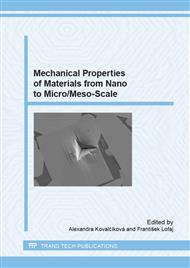p.123
p.129
p.134
p.138
p.142
p.147
p.151
p.155
p.161
Local Mechanical Properties of Highly Porous Si3N4 for Trabecular Bone Replacement
Abstract:
The study deals with the development of highly porous undegradable ceramics based on silicon nitride as potential replacement of trabecular bone. These materials were produced using replication method with polyurethane foams as pore-forming agents to achieve similar porous structure to trabecular bone. Prepared porous ceramics had a bimodal pore structure with macro-pores larger than 200 μm and micro-pores smaller than 1 μm in diameter, which are necessary for tissue ingrowths, cell adhesion, adsorption of biological metabolites and nutrition delivery in organism. The microstructure and local mechanical properties (Young’s modulus and Yield strength) were evaluated and compared with human trabecular bone. Results showed that studied porous materials have satisfactory porosity and pore sizes for trabecular bone replacement. Young’s modulus of bone was 12.6 ± 2.23 GPa and porous silicon nitride samples ranged from 10.9 ± 3.38 GPa to 12.9 ± 1.13 GPa. The values of Yield strength of trabecular bone was determined as 493 ± 30.7 MPa and the values of porous samples varied from 250 ± 19.3 MPa to 558 ± 36.5 MPa. Young’s modulus and Yield strength increase with increasing of the pre-sintering temperature and multiple infiltrations.
Info:
Periodical:
Pages:
142-146
Citation:
Online since:
September 2015
Keywords:
Price:
Сopyright:
© 2015 Trans Tech Publications Ltd. All Rights Reserved
Share:
Citation:


